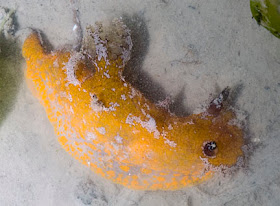Changi is one of the best places to spot nudibranchs! Also sea stars, multicoloured sea cucumbers, weird cnidarians and more!
Today I'm solo at Changi and had a great time exploring this tiny but rich shore.
I have no idea kind of nudibranch it is. A closer look shows it has a fringe around the 'mouth', hand-like bumps on the body and a rather large frilly breathing gills on its back. I'm sure Chay Hoon will know what it is.
The seagrass meadows of Changi are stupendously rich! Here is a posed 'family portrait' of some of the more common animals we might see. Changi is particularly rich in echinoderms. Today I only saw the usual sea stars: lots of Biscuit stars (Goniodiscaster scaber) in various sizes, one small Cake sea stars (Anthenea aspera) and one Painted sand star (Astropecten sp.). I guess the rest of the team have to be there to find the special sea stars.
How delightful to see the psychedelic Sea apple sea cucumber (Pseudocolochirus violaceus). Its eye-poking clashing colour combinations warn of its toxic nature. It's not a good idea to put one of these in an aquarium as it may kill all the animals in the tank. This sea cucumber is clinging onto a Fan clam (Family Pinnidae) which were plentiful on the shore.
A little further on, I saw another Sea apple! Good to know that these sea cucumbers are being left alone on the shore.
There are all kinds of sea cucumbers on this shore: I saw one Orange sea cucumber and many Warty pink sea cucumbers (Cercodemas anceps) and Thorny sea cucumbers (Colochirus quadrangularis). There were also many buried Ball sea cucumbers (Phyllophorus sp.). But I didn't see any Purple sea cucumbers.
Hurray! There is interest in this See-through sea cucumber (Paracaudina australis) and I've been waiting for the low spring tides to find one. So I'm very glad to spot one today.
There were some White sea urchins (Salmacis sp.) and some Black sea urchins (Temnopleurus sp.). They were quite well dispersed.
I also saw this tiny fish that I've not seen before. I'm not sure what it is.
I saw two Seagrass pipefishes. I checked and one of them seemed to be carrying eggs under his belly which was distended. But sadly, today I didn't see any Estuarine seahorses (Hippocampus kuda).
Cerianthids (Order Ceriantharia) are also abundant on this shore. Sometimes called peacock anemones because they are so colourful, although they are not true sea anemones. There seems several different kinds of cerianthids, but our cerianthids have yet to be identified.
This cerianthid is particularly elegant with tapering tentacles.
There are lots of sea anemones on Changi. Including some medium sized Haddon's carpet anemones (Stichodactyla haddoni) and several Tiny carpet anemones (Stichodactyla tapetum). There are still many of the yet-to-be-identified Tiger anemone. And I saw one Swimming anemone (Boloceroides mcmurrichi) and a few Peachia anemones (Peachia sp.). I also came across some of the sea anemones that Dr Daphne is interested in. Hurray!
There were also a few small Ball flowery soft corals (Family Nephtheidae).
These blobs on a hard surface are not sea anemones but corallimorphs! When expanded they have transparent tentacles tipped with balls.
This shore also has lots of sea pens, so named because some of the frilly ones resemble quill feathers used for writing long ago. While some are feathery like the Spiky sea pens (Scytalium sp.) which are often home to tiny Painted porcelain crabs (Porcellanella picta), others look like sticks: The Sea pencil, Flowery sea pens (Family Veretillidae) and Slender sea pens (Virgularia sp.).
Aha, this flopped over pile of transparent stuff is not seaweed. It's actually an animal. Possibly some kind of hydroid. I managed to get a closer look at the super tiny polyps that emerge from the transparent branches.
I also decided to take a closer look at this fluffy orange hydroid that we often see growing on hard surfaces. The colony is made up of pretty daisy-like polyps.
Also among the hydroids were lots of 'skeleton shrimps', which are not shrimps but some other kind of animal.
Peeping out of its hiding place, a small Seagrass octopus! I only see this kind of octopus on Changi. It seems to be different from the kind we see on our reefs in the South.
There were also many large fat Geographic sea hares (Syphonota geographica). Some were half buried, while this one reveals the inner shell that is usually hidden between the two flaps of its body.
There were lots of theseCalf moon snail (Natica vitellus) on the shore today, some appear to be mating. I also saw two Tiger moon snails (Natica tigrina).
I saw this very large bristleworm!
I came across this weird assembly of bits. Later on I realise it was a tubeworm that had fallen apart!
Today, I came across two tiny Sponge crabs (Family Dromiidae) which were carrying ascidians as a disguise.
The meadows are dominated by Spoon seagrass (Halophila ovalis) which have large leaves here. In some parts of the shores, the seagrass blades had lost their green stuff. Oh dear. I don't know what this means.
On the rockier parts of the shore, there are lots of colourful sponges, especial the Pink sponges (Haliclona cf baeri)! But I didn't see any sea fans (Order Gorgonacea) today.
Alas, a fishing line is entangled on this purple branching sponge (Callyspongia sp.).
At sunrise, a few people started to wander the seagrass meadows. Like this man with a stick and a plastic bag.
There was one person cast netting in deeper waters, and one or two who stopped by to collect stuff.
My previous morning trip to Changi was in July 2011. It's good to know that the shore remains lively and well.






























